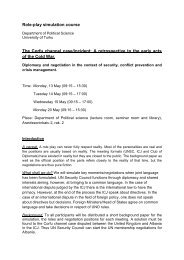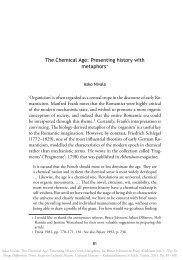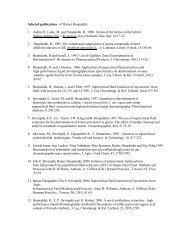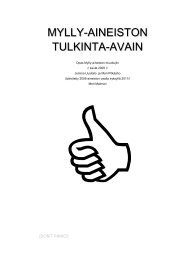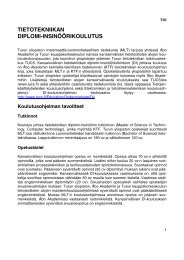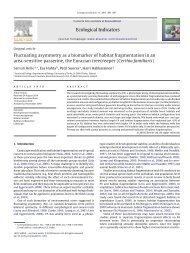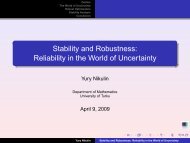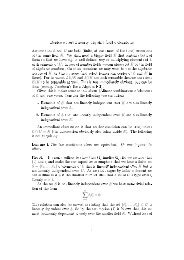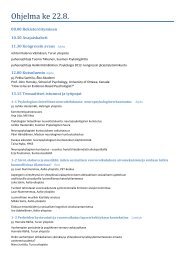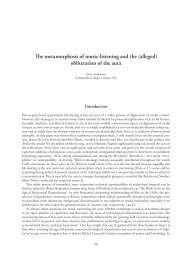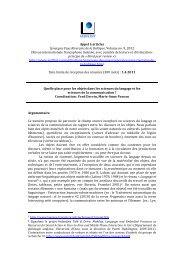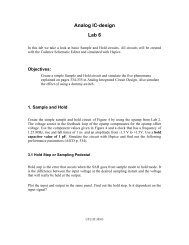MIRHAMI 2030 “Future Images of Food Consumption", Phase
MIRHAMI 2030 “Future Images of Food Consumption", Phase
MIRHAMI 2030 “Future Images of Food Consumption", Phase
You also want an ePaper? Increase the reach of your titles
YUMPU automatically turns print PDFs into web optimized ePapers that Google loves.
SECTION II: GLOBAL REPORT SUMMARY & ANALYSIS<br />
Mirhami <strong>2030</strong><br />
2.1.7 Production Comparatives – Agriculture<br />
The OECD <strong>Food</strong>, Agriculture and Fisheries (within the Department for Trade and Agriculture)<br />
produce a compilation <strong>of</strong> “Producer and Consumer Support Estimates”. The table below is<br />
excerpted from the latest data (2004).<br />
Production:<br />
Total Value at<br />
farm gate<br />
Consumption:<br />
Total value at<br />
farm gate<br />
Variance<br />
(production less<br />
consumption)<br />
© Finpro & Finland Futures Research Centre<br />
Canada China EU (all)<br />
incl. Finland<br />
& Germany<br />
Japan Russia US<br />
CAD $mn LC mn EUR mn ¥ bn Rb mn US $ mn<br />
31,450 2,440,890 250,933 8,904 930,863 225,437<br />
21,548 2,698,029 249,329 13,107.4 1,163,317 206,594<br />
+ 9,902 257,139 + 1,604 4,203.4 232,454 + 18,843<br />
Data not available for India.<br />
Data for the European Union is combined, not separated.<br />
2004 data except China and Russia (2003 data).<br />
By looking only at this table, in 2003/2004 those countries with and excess <strong>of</strong> agricultural<br />
production are the USA, Canada, and Europe. Those countries with an agricultural deficit are<br />
China, Japan, and Russia. This conforms to the comments supplied in the 2006 global reports<br />
analyzed by Finpro.<br />
2.1.8 Import structures<br />
Simple ratios showing the shares <strong>of</strong> imports as a percent <strong>of</strong> total final demand, and intermediate<br />
consumption in particular, provide an indication <strong>of</strong> the degree <strong>of</strong> integration/interdependencies<br />
<strong>of</strong> economies in the global supply chain, although some care is needed in interpretation as flows<br />
<strong>of</strong> intermediate consumption <strong>of</strong> domestically produced goods are measured gross and because<br />
comparisons are not made at constant prices. Nevertheless the tables provide a strong<br />
indication that these interdependencies are growing, indeed since the 1990s these ratios have<br />
increased in 29 out <strong>of</strong> 31 countries, with, not surprisingly, a negative correlation between the<br />
economic size <strong>of</strong> a country and these ratios.<br />
Country<br />
Intermediate Final Demand<br />
mid90s early00s mid90s early00s<br />
Canada 24.2% 26.4% 18.6% 21.0%<br />
* China 7.9% 9.6% 6.4% 7.7%<br />
Finland 20.0% 23.9% 15.7% 17.3%<br />
Germany 15.3% 20.0% 11.1% 14.8%<br />
Japan 6.4% 7.8% 4.7% 5.8%<br />
Unites States 6.7% 7.6% 5.8% 6.7%<br />
* Russia 12.6% 14.3% 11.7% 13.5%<br />
* Non OECD Member, source: OECD IO tables.<br />
19




